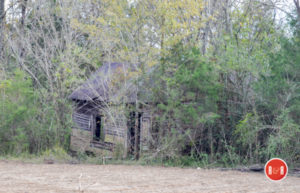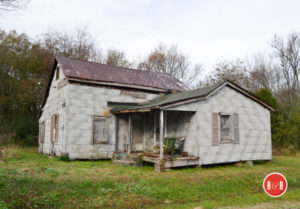I am convinced Oliver W. Holmes statement, “houses hold on to those who have lived within their walls,” is indeed accurate and appropriate to this day. While recently visiting an old rural home, I put on my architectural forensics hat, and revealed to the current owners that indeed their old home held on to features of past generations and owners. This one house, though heavily updated, retained elements of mid-19th century architecture from a post Civil War remodeling and from updates in the 21st century. Each family that had lived there over the course of nearly two hundred years had left their footprints. A few family pieces of furniture were even intact and on display, although it seemed no one wanted the old antebellum furniture. One piece was made by a local cabinet maker, whose work is documented but whose name remains a mystery.

Historic Cork Family Cabin – Fairfield Co SC
Several years ago, in an earlier blog post, we strongly suggested our homes do hold a piece of us long after we have moved on. We heard from several subscribers who stated they were of like mind! What was unusual was that we also received a visit from a friend, telling of his trip to Georgia, to document an antebellum home that remains in the same family, having had little or no changes. Remarkably the house retains many of the original furnishings and the entire estate is kept intact as an evolution of family heritage. The home is not open to the public and appears to be one of the best-kept secrets in preservation!
As our society continues to become increasingly mobile, this type of situation will be seen even less often. Multi-generational homeplaces unfortunately are becoming a rarity, while prior to WWII, they were extremely common. Uncovering ghost marks, wall paintings, attic signatures and vestiges of intergenerational living is clearly becoming a rarity in modern society where we frequently paint and remodel.
As most of you who read the blog know, we are all saddened by the rapid demise of old homes throughout the rural South. Many of these are no more than forgotten tenant houses, lived in by those who labored alongside the farmer who owned the land. But we also think it is important to remember that these individuals contributed significantly to society and to their communities. As one R&R user commented, “we didn’t own that house but it was our home.” So take a look at a few of the images we recently took on a short trip to Newberry, S.C. These simple houses were someone’s homes and they too hold stories worth preserving.
R&R has numerous statewide authors and researchers who regularly contribute outstanding research. Preserving local history, one address at a time. Check out the two articles below for some of these meaningful contributions. What are you holding on to that you too could easily share?
Read about the cabin and its architectural features at: Cork Cabin
Recent updates worth visiting: Henry Sigwald House and the Nitrolee Fertilizer Plant
- Interesting houses holding stories that will most likely never be revealed. R&R Photographs – 2018
R&R Note: Our last blog post called attention to the work R&R has been performing on old store ledgers from Laurens and Lancaster counties. We were excited to receive numerous notes from members expressing their gratitude and excitement in using the Kellett Store journals. Thank you for your positive comments!




